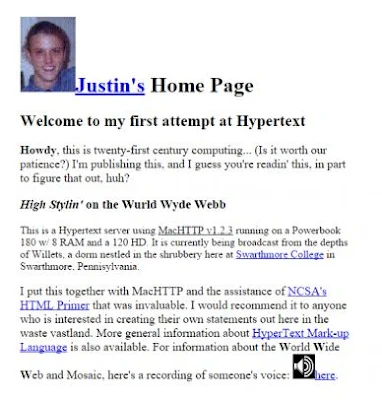All About Blog
Pertama GoBlog - Blog is short for Weblog, the term was first used by Jorn Barger in December 1997.
Jorn Barger uses the term Weblog to refer to a group of personal websites that are updated continuously and contain links to other websites that they find interesting along with their own comments.
Weblogs can be interpreted as a collection of personal websites that allow their creators to easily display various types of content on the web, such as written works, collections of internet links, documents (Word files, PDF, etc.), images or multimedia.
There are also those who define a blog as a personal site, which focuses more on the description of the person who created the blog itself.
A blog is a type of website that is usually arranged in chronological order from the most recent 'post' (or entry) at the top of the main page to the older entries towards the bottom.
Blog (from the word web log) is a form of web application in the form of writings (which are loaded as posts) on a web page.
These writings are often listed in the order of the newest content first before the older content, although this is not always the case.
Websites like this can usually be accessed by all internet users according to the topic and purpose of the blog user [Wikipedia].
Understanding Blogs in general is a website or online journal that contains a variety of information and displays the latest posts at the top of the page, content or blog posts are updated regularly, and are usually managed by one or a small group of users (the user), even though it is managed by many users (the user), (the user), for example, the thoughts and opinions written remain focused on one topic.
Blog History
 |
| Justin Hall until now is known as the creator of the blog or the first blogger in the world. This is the screenshot of the blog |
The first blog was most likely the "What's New" page on the Mosaic browser created by Marc Andersen in 1993.
Mosaic was the first browser before Internet Explorer and even before Nestscape.
In January 1994 Justin Hall started his personal website "Justin's Home Page" which later turned into "Links from the Underground" which may be called the first Blog as we know it today.
Until 1998, the number of existing blogs was still very small. This is because at that time it required special skills and knowledge about website creation, HTML, and web hosting to create a blog, so that only those who were involved in the Internet, System Administrators or Web Designers who then in their spare time created their own Blogs.
Around 1994 Blogs were introduced to the internet with a personal journal created by Justin Hall.
This journal is published online on a site called links.net. It looks very simple with a white background.
Justin Hall later earned the nickname The Founding Father of Personal Blogger.
 |
| Barger was the first to use the term "Weblog" to describe the process of "logging the web links" that he collected on the internet |
Weblog is a term coined by Jorn Barger on December 17, 1997. The term weblog is used to refer to logging activities to the web.
Jorn Barger was the first to introduce the concept of chronology to weblogs based on the time of posting.
A few years later, the mention of Blogs is getting more and more widely heard. The concept itself turns out to be more than two decades old, which in terms of the internet can be considered millions of years old.
Blogging began to surface at the beginning of the second millennium. Examples of Blogs and Blogging have a significant impact seen in 2002, an important year in the history of blogs.
Because the Blog is still new, its appearance raises controversy.
You could say, as a "compromise"; Jorn Barger is the inventor of the term Blog and Justin Hall is the first Blogger.
In 1999, Peter Merholz began to introduce the word Blog which he considered more comfortable to pronounce than weblog.
This year also began to appear variations of Blogs such as Blogger, Xanga, and/or LiveJournal.
Media Blog was first popularized by Blogger.com, which was owned by Pyra Labs before it was finally acquired by Google at the end of 2003, in that year became the year of significant Blog development.
This year also appears a competitor to Blogger, namely WordPress. Both exist and dominate the world of blogs to this day.
Since then, there have been many open source applications for the development of these blog writers.
Rapid developments occurred in WordPress which dominated the blogger world in 2018.
Almost 50% of bloggers use the services of WordPress.
While Blogger is only used by 2% of Blog writers only.
WordPress develops its platform with promising services such as basic websites to online stores.
Structure on Blog
Blog structure consists of a header that has a menu and/or navigation bar.
The main content section displays the latest or highlighted Blog posts.
There is also a sidebar that displays the author's social media profiles and the most popular posts.
Finally, the footer contains information, such as a privacy policy, disclaimer, and contact information.
Every aspect of the structure plays a very important role in making it easier for site visitors to navigate and search for content.
Currently Blogs have a very diverse appearance and arrangement depending on the function of the Blog itself. Starting from a blog that has several sidebars, to a blog that only has one column.
Basically Blogs have a standard structure, here are some standard structures on a Blog:
 |
| Blog structure |
Header
Usually located at the top of the Blog. The header contains the Blog title, Blog description and Blog menu.
Navbar
This element is usually located above the header. The function of the Navbar is to make it easier for blog users (editors/ owners) to manage their blogs.
Navbar usually will not appear if accessed by users other than the blog owner.
Main Blog
Usually located in the middle of the Blog. This is where the blog posts are located.
On the Main Blog there are also structures such as title, date, author's name and comment column.
Sidebar
This element usually contains Popular Post, Archive. Users can also add other widgets such as calendar, clock and other interesting widgets.
It can be located on the left or right of a blog.
Footer
Located at the bottom of the Blog. Usually there is a brief information on the blog owner, contact or subscribe form to fill in the email address.
Functions and Benefits of Blogs
Blogs have very diverse functions, ranging from a diary, media publication in a political campaign, to media programs and companies.
Some Blogs are maintained by a single author, while others are by multiple authors.
There are also many blogs that have interaction facilities with their visitors, such as using a guest book and comment column that can allow visitors to leave comments on the content of published articles, however, there are also blogs that are the opposite (non-interactive).
There are many reasons people or companies use a blog.
For example, if you have an interest in computers, hobbies, personal experiences and want to share some tips or knowledge that can be useful for others, you can share them through the blog.
Or also companies that want to provide information about the products to be sold.
Blogs can function as online information media with various topics.
Blogs also have a function as a diary, publication media in a political campaign and much more.
Here are some functions of the Blog and their explanations are as follows:
Increase Brand Awareness
First, by developing various articles through the right SEO writing process, you can increase brand awareness of your site's products.
So, you can get high traffic support and in accordance with your business campaign or personal branding.
As a Media for Publication
Second, it functions as a publication medium that is quite effective without having to incur expensive costs.
This type of publication tends to prioritize increasing visitors through organic search methods without having to advertise or use SEM (Search Engine Marketing) techniques.
To Display Up-to-Date Information
Third, being able to display the latest information and news updates quickly and reach a wider target user.
Which, will correlate with increased awareness of your product brand or personal identity.
The world of technology that is increasingly developing makes various activities all online.
Starting from looking for information or news, social networking, accessing entertainment, downloading software to running a business, shopping online, and so on. Likewise with blogs.
Blogs have an important role to provide content that can be accessed by online users.
Various content can be shared in cyberspace so that anyone who is connected to the internet can access and download it easily.
The following are some of the benefits of a blog, including:
- Share your writings, both in the form of knowledge, stories, and experiences so that others who are looking for a particular topic can find your writing.
- Practice writing skills and creativity because for people who like to write, blogs will be a means of honing writing skills.
- Can make money, for example by following PPC, Affiliate business, and others.
- Expanding and building a network can be done in the world of bloggers. Technically, if you want to add a comment then there will be a record of the email address that goes to us and we can use it for the mailing list. It can even be used as a target to promote your product. In addition, with other bloggers you can share, exchange links, and so on.
- Promotional media or means to sell products for reasons of offline stores that are less strategic. With the rise of the online world, anything can be sold and the media for selling online can also be through blogs.
- Self-actualization media because a blogger will learn to develop and explore further and share their knowledge through writing. For example, you like about an application, then you are more motivated to explore further and then share on the Blog. You can share and show the world your work.
- Media of communication and socialization with visitors on your Blog. The trick is that you reply to their comments regarding your writing on the Blog. You can also continue the interaction of mutual comments in the real world by way of land copies with various blogger communities.
That's the discussion about it All About Blog, hopefully it can be useful.
Thanks.
#from various sources

Post a Comment